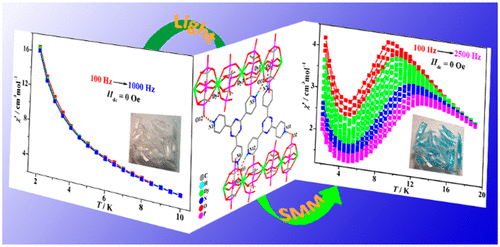当前位置:
X-MOL 学术
›
J. Am. Chem. Soc.
›
论文详情
Our official English website, www.x-mol.net, welcomes your feedback! (Note: you will need to create a separate account there.)
Manipulating On/Off Single-Molecule Magnet Behavior in a Dy(III)-Based Photochromic Complex
Journal of the American Chemical Society ( IF 15.0 ) Pub Date : 2020-01-20 , DOI: 10.1021/jacs.9b13461 Yu-Juan Ma 1 , Ji-Xiang Hu 1 , Song-De Han 1 , Jie Pan 1 , Jin-Hua Li 1 , Guo-Ming Wang 1
Journal of the American Chemical Society ( IF 15.0 ) Pub Date : 2020-01-20 , DOI: 10.1021/jacs.9b13461 Yu-Juan Ma 1 , Ji-Xiang Hu 1 , Song-De Han 1 , Jie Pan 1 , Jin-Hua Li 1 , Guo-Ming Wang 1
Affiliation

|
Exploitation of room temperature (RT) photochromism and photomagnetism to induce single-molecule magnet (SMM) behavior has potential applications toward optical switches and magnetic memories, and remains a tremendous challenge in the development of new bulk magnets. Herein, a series of chain complexes [Ln3(H-HEDP)3(H2-HEDP)3]⸱2H3-TPT⸱H4-HEDP⸱10H2O (QDU-1; Ln = Dy (QDU-1(Dy)), Gd (QDU-1(Gd)), and Y (QDU-1(Y)); HEDP = hydroxyethylidene diphosphonate; TPT = 2,4,6-tri(4-pyridyl)-1,3,5-triazine) were synthesized by solvothermal reactions. All the compounds exhibited reversible photochromic and photomagnetic behaviors via UV light irradiation at RT, induced by the photogenerated radicals via a photo-induced electron transfer (PET) mechanism. More importantly, the PET process induced significant variations in magnetic interactions for the Dy(III) congener. Strong ferromagnetic coupling with remarkably slow magnetic relaxation without applied dc fields was observed between DyIII ions and photogenerated O˙ radicals, showing SMM behavior after RT illumination. For the first time, we observed the reversible RT photochromism and photomagnetism in the lanthanide-based materials. This work realized the radicals-actuated on/off SMM behavior via RT light irradiation, providing a new strategy for constructing the light-induced SMMs.
中文翻译:

在基于 Dy(III) 的光致变色复合物中操纵开/关单分子磁铁行为
利用室温 (RT) 光致变色和光磁性来诱导单分子磁体 (SMM) 行为在光开关和磁存储器方面具有潜在的应用,并且在开发新的块状磁体方面仍然是一个巨大的挑战。在此,一系列链络合物[Ln3(H-HEDP)3(H2-HEDP)3]⸱2H3-TPT⸱H4-HEDP⸱10H2O(QDU-1;Ln=Dy(QDU-1(Dy)),Gd (QDU-1(Gd)) 和 Y (QDU-1(Y));HEDP = 羟基亚乙基二膦酸酯;TPT = 2,4,6-三(4-吡啶基)-1,3,5-三嗪)通过溶剂热反应。所有化合物通过室温下的紫外光照射表现出可逆的光致变色和光磁行为,由光生自由基通过光诱导电子转移(PET)机制诱导。更重要的是,PET 过程导致 Dy(III) 同系物的磁相互作用发生显着变化。在没有施加直流场的情况下,在 DyIII 离子和光生 O· 自由基之间观察到强铁磁耦合和显着缓慢的磁弛豫,显示 RT 照射后的 SMM 行为。我们首次在镧系元素材料中观察到可逆的 RT 光致变色和光磁性。这项工作通过 RT 光照射实现了自由基驱动的开/关 SMM 行为,为构建光诱导 SMM 提供了一种新策略。我们在镧系元素基材料中观察到可逆的 RT 光致变色和光磁性。这项工作通过 RT 光照射实现了自由基驱动的开/关 SMM 行为,为构建光诱导 SMM 提供了一种新策略。我们在镧系元素基材料中观察到可逆的 RT 光致变色和光磁性。这项工作通过 RT 光照射实现了自由基驱动的开/关 SMM 行为,为构建光诱导 SMM 提供了一种新策略。
更新日期:2020-01-20
中文翻译:

在基于 Dy(III) 的光致变色复合物中操纵开/关单分子磁铁行为
利用室温 (RT) 光致变色和光磁性来诱导单分子磁体 (SMM) 行为在光开关和磁存储器方面具有潜在的应用,并且在开发新的块状磁体方面仍然是一个巨大的挑战。在此,一系列链络合物[Ln3(H-HEDP)3(H2-HEDP)3]⸱2H3-TPT⸱H4-HEDP⸱10H2O(QDU-1;Ln=Dy(QDU-1(Dy)),Gd (QDU-1(Gd)) 和 Y (QDU-1(Y));HEDP = 羟基亚乙基二膦酸酯;TPT = 2,4,6-三(4-吡啶基)-1,3,5-三嗪)通过溶剂热反应。所有化合物通过室温下的紫外光照射表现出可逆的光致变色和光磁行为,由光生自由基通过光诱导电子转移(PET)机制诱导。更重要的是,PET 过程导致 Dy(III) 同系物的磁相互作用发生显着变化。在没有施加直流场的情况下,在 DyIII 离子和光生 O· 自由基之间观察到强铁磁耦合和显着缓慢的磁弛豫,显示 RT 照射后的 SMM 行为。我们首次在镧系元素材料中观察到可逆的 RT 光致变色和光磁性。这项工作通过 RT 光照射实现了自由基驱动的开/关 SMM 行为,为构建光诱导 SMM 提供了一种新策略。我们在镧系元素基材料中观察到可逆的 RT 光致变色和光磁性。这项工作通过 RT 光照射实现了自由基驱动的开/关 SMM 行为,为构建光诱导 SMM 提供了一种新策略。我们在镧系元素基材料中观察到可逆的 RT 光致变色和光磁性。这项工作通过 RT 光照射实现了自由基驱动的开/关 SMM 行为,为构建光诱导 SMM 提供了一种新策略。



























 京公网安备 11010802027423号
京公网安备 11010802027423号